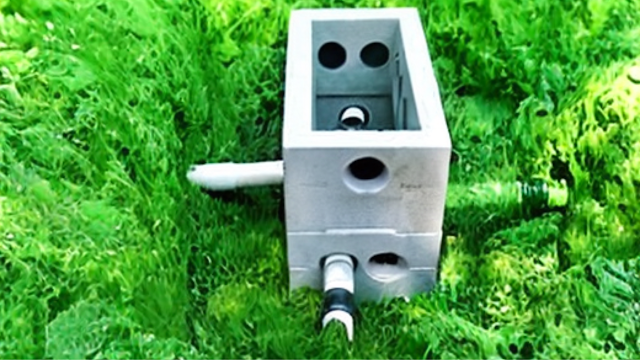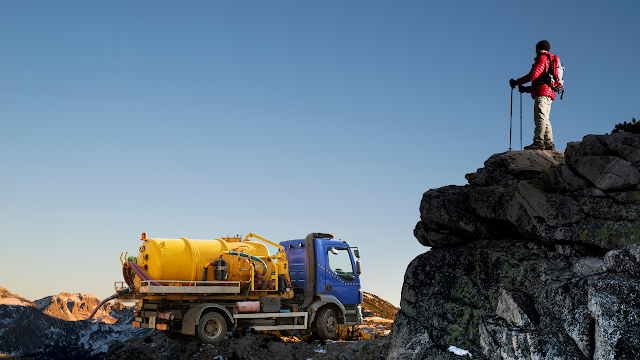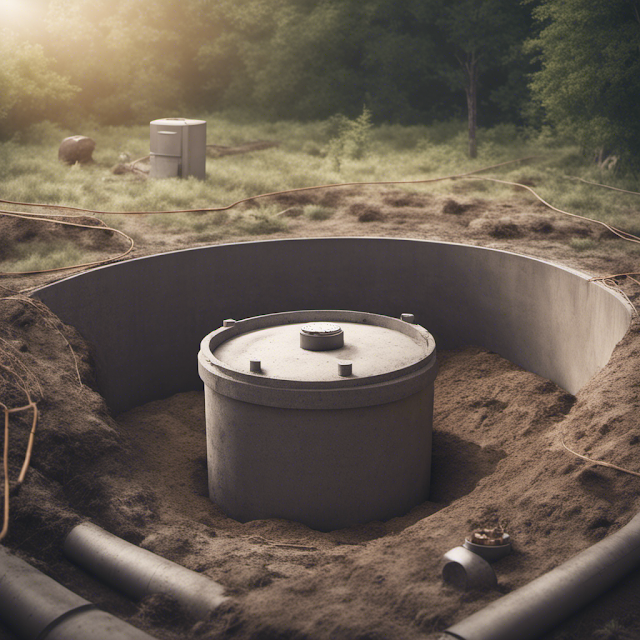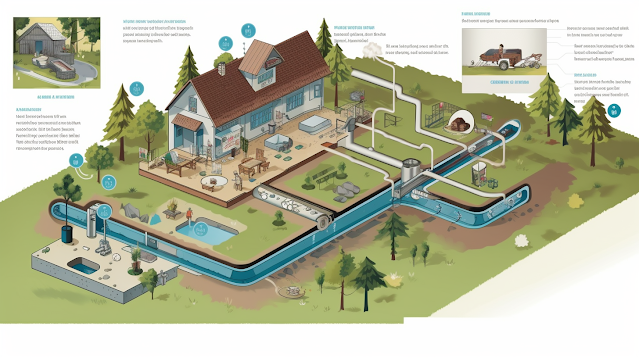Contaminated Soil From Septic Tank: Risks And Remediation
 |
| Contaminated Soil From Septic Tank: Risks And Remediation |
Contaminated soil from septic tanks
poses significant risks to both human health and the environment. Understanding
the function and maintenance of septic systems is crucial in preventing system
failure, which can lead to soil contamination.
When septic systems fail, they release
pathogens and pollutants into the soil, resulting in potential health hazards
for individuals exposed to contaminated areas. Furthermore, contaminated soil
can have detrimental environmental impacts, including water contamination and damage
to ecosystems.
Fortunately, there are remediation
techniques available to address this issue. Soil removal and replacement
methods are commonly employed but can be costly and disruptive. Bioremediation
offers a more sustainable solution by utilizing microorganisms to break down
contaminants naturally.
To prevent soil contamination from septic
tanks, it is essential for septic system owners to follow best practices such
as regular maintenance, proper waste disposal, and avoiding excessive water
usage.
By understanding the risks associated
with contaminated soil from septic tank failures and implementing effective
remediation strategies, we can safeguard our health and protect our
environment.
Key Takeaways
•
Contaminated soil from septic
tanks poses significant risks to human health and the environment.
•
Prompt remediation techniques
such as soil removal, bioremediation, and physical and chemical methods are
necessary to address soil contamination.
•
Regular maintenance, proper
waste disposal, and water conservation are essential for preventing septic
system failure and soil contamination.
•
Direct contact, ingestion, or
inhalation of contaminated soil can result in various health issues, and it can
also lead to water contamination, air pollution, and disruption of ecosystems.
Understanding
Septic System Function and Maintenance
If you don't properly maintain your septic system, you're putting
yourself at risk for potential contamination of the soil and groundwater
surrounding your property. Septic systems play a crucial role in treating and
disposing of wastewater from households that aren't connected to a municipal
sewer system. Understanding how these systems function and implementing regular
maintenance practices is essential to prevent any potential risks.
A septic system consists of a septic tank and a drainfield. When
wastewater flows into the septic tank, it undergoes a separation process. Solid
waste settles at the bottom, while scum floats on top. The liquid portion,
known as effluent, exits the tank and enters the drainfield through perforated
pipes or trenches. In the drainfield, bacteria in the soil further treat the
effluent before it reaches groundwater.
Regular maintenance includes performing periodic inspections,
pumping out accumulated solids from the tank every three to five years, and
avoiding improper disposal practices such as flushing non-biodegradable items
or excessive use of chemicals that can disrupt bacterial activity in the tank.
Failure to properly maintain your septic system can lead to various
issues such as clogged pipes, backups inside your home, foul odors, or even
complete system failure. When a septic system fails, untreated wastewater can
contaminate surrounding soil and groundwater with harmful pathogens and
pollutants.
Understanding proper septic system maintenance is paramount for
protecting both human health and environmental integrity. By following
recommended guidelines for inspection and maintenance, you can ensure that your
septic system operates efficiently without posing any risks to soil or
groundwater quality.
Now let's explore common causes of septic system failure...
Common
Causes of Septic System Failure
When your septic system fails, there are several common causes that
you should be aware of. One of the main reasons for septic system failure is
improper maintenance. Neglecting regular pumping and cleaning can lead to a
buildup of solid waste in the tank, causing it to overflow or clog.
Another common cause is excessive water usage. Using too much water
in a short period of time can overwhelm the system and prevent proper treatment
and drainage.
Inadequate design or installation can also contribute to septic
system failure. If the tank is not sized correctly for the household's
wastewater volume, or if it is installed in unsuitable soil conditions,
problems may arise. Additionally, tree roots can infiltrate sewer lines and
disrupt the flow of wastewater, leading to backups and malfunctions.
Chemical additives and harsh cleaning products can harm the
beneficial bacteria in your septic tank that are responsible for breaking down
waste. Avoid using these substances as they can interfere with the natural
treatment process and potentially damage your system.
Understanding these common causes of septic system failure is
essential in preventing future issues. By properly maintaining your septic
system, conserving water, avoiding harmful chemicals, and ensuring a suitable
design and installation, you can minimize the risk of failure.
In the next section about pathogens and pollutants in contaminated
soil, we will explore how a failed septic system can result in dangerous
substances entering the surrounding environment without proper remediation
measures.
Pathogens
and Pollutants in Contaminated Soil
One major concern with a failed septic system is the potential for
dangerous substances to infiltrate the surrounding environment. When a septic
system fails, pathogens and pollutants can contaminate the soil, posing significant
risks to human health and the ecosystem.
Pathogens found in contaminated soil from a septic tank include
bacteria such as Escherichia coli (E. coli), Salmonella, and Campylobacter.
These pathogens can cause gastrointestinal illnesses, including diarrhea,
vomiting, and abdominal pain. Additionally, viruses like hepatitis A may also
be present in contaminated soil and can lead to severe liver infections.
In addition to pathogens, various pollutants can contaminate the
soil from a failed septic system. These include nitrates, which are harmful to
infants and pregnant women; heavy metals like lead and arsenic that can
accumulate in plants; pharmaceuticals that may enter the food chain through
plant uptake; and organic compounds such as pesticides or solvents that may
persist in the environment for extended periods of time.
The presence of these pathogens and pollutants in contaminated soil
poses several health risks. Direct contact with contaminated soil can result in
skin irritation or infection. Ingesting or inhaling particles from contaminated
soil can lead to respiratory issues or other systemic effects depending on the
specific contaminant involved.
It is crucial to address these risks promptly by implementing
remediation measures that focus on removing contaminants from the soil or
preventing their migration further into the environment. By doing so, we can
minimize potential health hazards associated with contaminated soil while
safeguarding both human well-being and ecological integrity.
Transitioning into discussing the 'health risks associated with
contaminated soil,' it is important to understand how these contaminants impact
our overall well-being without delay.
Health
Risks Associated with Contaminated Soil
Explore the potential health hazards that can arise from coming into
contact with soil contaminated by pathogens and pollutants, as it may lead to
gastrointestinal illnesses, respiratory issues, and other systemic effects.
Contaminated soil poses a significant risk to human health due to
the presence of various harmful substances. Pathogens such as bacteria,
viruses, and parasites are commonly found in contaminated soil and can cause
severe gastrointestinal infections when ingested or transferred through
hand-to-mouth contact. These pathogens include Salmonella, Escherichia coli
(E.coli), Campylobacter, and Giardia lamblia.
In addition to pathogens, pollutants present in contaminated soil
can also have adverse health effects. Heavy metals like lead, cadmium, arsenic,
and mercury are often found in contaminated soil from industrial activities or
improper waste disposal. Exposure to these toxic metals can lead to
neurological disorders, kidney damage, developmental issues in children, and
even cancer.
Moreover, volatile organic compounds (VOCs) released from petroleum
products or solvents can contaminate the surrounding soil. Inhalation or dermal
absorption of VOCs can result in respiratory problems such as asthma
exacerbation or irritation of the eyes and skin.
It is crucial to note that the severity of health risks depends on
factors like concentration levels of contaminants in the soil, duration of
exposure, age of individuals exposed (children being more vulnerable), and
individual susceptibility. Therefore, proper precautions should be taken when
working with or living near areas with contaminated soils.
Transitioning into the subsequent section about environmental
impacts of contaminated soil: Understanding the potential health risks
associated with contaminated soil is vital; however, it is equally important to
recognize its broader environmental implications.
Environmental
Impacts of Contaminated Soil
The presence of pollutants in soil can have far-reaching
consequences for the environment. Contaminated soil poses a significant risk to
ecosystems, as it can lead to the contamination of water sources, air
pollution, and the loss of biodiversity.
When contaminants seep into water bodies, they can harm aquatic
organisms and disrupt the delicate balance of these ecosystems. Additionally,
contaminated soil can release harmful gases into the atmosphere, contributing
to air pollution and potentially affecting human health.
One of the main environmental impacts of contaminated soil is thepotential for groundwater contamination. As pollutants leach through the soil
layers, they can reach underground aquifers that serve as a source of drinking
water for communities. This contamination not only affects human health but
also poses risks to plants and animals that rely on clean water.
Furthermore, contaminated soil can have adverse effects on
biodiversity. Soil serves as a habitat for countless organisms such as insects,
worms, and microorganisms. When these organisms are exposed to pollutants,
their populations may decline or disappear entirely. This loss of biodiversity
has cascading effects on entire ecosystems, disrupting nutrient cycles and
impairing ecosystem functions.
Contaminated soil poses significant environmental risks including
water contamination and loss of biodiversity. These impacts highlight the
importance of addressing and remediating contaminated soil to protect our
ecosystems and ensure long-term sustainability. Testing and assessing soil
contamination is crucial in identifying areas that require remediation efforts
to mitigate these environmental impacts.
[Transition sentence: In order to effectively address this issue...]
Testing
and Assessing Soil Contamination
To effectively address this issue, it's crucial to employ methods
for testing and assessing the contamination levels in soil.
Testing soil for contamination involves several steps that aim to
identify and quantify the presence of harmful substances. One common method is
soil sampling, which involves collecting samples from different locations
within the contaminated area. These samples are then analyzed in a laboratory
using various techniques such as chemical analysis and spectroscopy.
Chemical analysis is used to determine the concentration of
contaminants in the soil sample. This process involves extracting substances
from the soil using solvents or other extraction methods, followed by measuring
their concentration using analytical instruments. Spectroscopy, on the other
hand, uses light absorption or emission properties of substances to identify
and quantify them in a sample.
Another important aspect of assessing soil contamination is
evaluating its potential impact on human health and the environment. This can
be done through risk assessment, which considers factors such as exposure
pathways (e.g., inhalation, ingestion), toxicity of contaminants, and
sensitivity of receptor organisms. Risk assessment helps determine whether
remediation is necessary and what level of cleanup is required.
Transitioning into the subsequent section about 'remediation
techniques for contaminated soil', it's important to note that once
contamination levels have been determined through testing and assessment,
appropriate measures can be taken to mitigate these risks. Remediation
techniques involve removing or treating contaminated soil to reduce or
eliminate harmful substances. By understanding the extent of contamination
through thorough testing and assessment, effective remediation strategies can
be implemented to restore contaminated areas back to their original state
without endangering human health or harming the environment further.
Remediation
Techniques for Contaminated Soil
After testing and assessing the soil contamination caused by septic
tanks, it's crucial to implement effective remediation techniques to mitigate
the risks associated with this problem. Remediation aims to restore the
contaminated soil to its original state or reduce the levels of contaminants to
acceptable limits.
Several techniques can be employed for remediating contaminated
soil, each tailored to specific contaminants and site conditions. One common
technique is bioremediation, which utilizes microorganisms to break down
organic contaminants into harmless byproducts through natural processes. This
method can be enhanced through bioaugmentation, where specific microbial
strains are added to enhance degradation rates.
Another approach is phytoremediation, which involves using plants
that have the ability to absorb and accumulate contaminants from the soil.
These plants then undergo either phytoextraction (removing contaminants via
plant uptake) or phytodegradation (breaking down contaminants within plant tissues).
Physical methods such as soil vapor extraction and air sparging can
also be employed. Soil vapor extraction involves removing volatile contaminants
from the soil by applying a vacuum system, while air sparging injects air into
groundwater or saturated soils to strip out volatile compounds.
Additionally, chemical methods like oxidation or reduction reactions
can be used for remediation purposes. Oxidation involves adding oxidizing
agents such as hydrogen peroxide or ozone to convert pollutants into less toxic
substances. Reduction reactions involve adding reducing agents like zero-valent
iron or sodium borohydride to transform harmful chemicals into harmless forms.
These various remediation techniques offer effective ways of
addressing contaminated soil caused by septic tanks. However, it's important to
evaluate site-specific factors before selecting an appropriate method for each
case.
Transitioning into our subsequent section on 'soil removal and
replacement methods,' we will explore alternative strategies for tackling this
issue without compromising environmental integrity.
Soil Removal
and Replacement Methods
Explore alternative strategies to address the issue of soil
contamination caused by septic tanks without compromising the integrity of the
environment. One effective method is soil removal and replacement, which
involves excavating and disposing of contaminated soil, then replacing it with
clean soil. This technique is commonly used when the contamination level is
high or when other remediation methods are not feasible.
The first step in this process is to identify the extent of soil
contamination through sampling and testing. Once the contaminated areas have
been determined, excavation can begin. Heavy machinery such as excavators or
backhoes is typically used to remove the contaminated soil from the site. Care
must be taken during this process to prevent further spread of contaminants.
After removal, the contaminated soil should be properly disposed of
in accordance with local regulations. It may need to be transported to a
licensed facility for treatment or disposal. Once all contaminated soil has
been removed, clean topsoil can be brought in and spread over the affected
area.
Soil removal and replacement is an effective technique for
remediating septic tank contamination because it physically removes pollutants
from the environment. However, it does have some drawbacks. It can be costly
due to excavation and transportation expenses, as well as purchasing clean
topsoil. Additionally, this method may disrupt existing vegetation and
habitats.
Transitioning into bioremediation: using microorganisms to clean
soil, another approach that can be utilized for septic tank contamination
remediation involves harnessing the power of microorganisms to break down
pollutants in soils.
Bioremediation:
Using Microorganisms to Clean Soil
Discover how harnessing the incredible power of microorganisms can
effectively cleanse and restore soil impacted by septic tank contamination.
Bioremediation, a natural process that utilizes microorganisms to break down
contaminants, has emerged as a promising solution for remediating contaminated
soils.
By introducing specific strains of bacteria or fungi into the
affected soil, these microorganisms can degrade organic pollutants found in
septic tank waste. The success of bioremediation lies in the ability of
microorganisms to metabolize contaminants as a food source. In the case of
septic tank contamination, certain bacteria have evolved to efficiently consume
and break down substances such as fats, oils, and greases. These microorganisms
convert complex organic molecules into simpler compounds through enzymatic
reactions, ultimately transforming harmful pollutants into harmless byproducts.
To initiate bioremediation, the contaminated soil is often treated
with a microbial inoculant containing these specialized microorganisms. This
inoculant is carefully applied at appropriate concentrations and environmental
conditions to optimize microbial activity. Factors like pH level, temperature,
oxygen availability, and nutrient content must be considered to ensure optimal
performance.
Over time, the introduced bacteria or fungi proliferate within the
contaminated soil matrix and start degrading organic pollutants present in
septic tank waste. As they consume these contaminants for energy and growth,
their population expands further until a significant reduction in pollutant
concentration is achieved.
Bioremediation offers a promising approach for restoring soil
impacted by septic tank contamination. By utilizing naturally occurring
microorganisms' capabilities to degrade organic pollutants found in septic
waste materials effectively, this method provides an environmentally friendly
alternative to traditional remediation methods like soil removal and
replacement.
Transitioning into the subsequent section about preventing soil
contamination: best practices for septic system owners emphasizes proactive
measures that help avoid future issues rather than dealing with them after they
occur—a crucial aspect of responsible septic system management.
Preventing
Soil Contamination: Best Practices for Septic System Owners
Taking proactive measures and implementing best practices can help
septic system owners prevent potential harm to their surroundings and ensure a
healthier environment for future generations. When it comes to preventing soil
contamination from septic tanks, there are several key practices that should be
followed.
Firstly, regular maintenance is crucial. Septic systems should be
inspected and pumped every 3-5 years to prevent overloading and leakage. This
will reduce the risk of contaminated wastewater seeping into the soil.
Additionally, monitoring the water usage in your household can also help
prevent excessive strain on the septic system.
Secondly, proper disposal of waste is essential. Avoid flushing
non-biodegradable items such as diapers, wipes, or feminine hygiene products
down the toilet. These materials can clog the system and lead to leaks or
backups.
Furthermore, it is important to minimize chemical usage in your
household. Harsh cleaning agents and chemicals can disrupt the natural balance
of microorganisms in the septic tank that are responsible for breaking down
waste. Instead, opt for environmentally-friendly cleaning products that are
biodegradable.
Additionally, maintaining a healthy drainfield is crucial in
preventing soil contamination. Avoid parking vehicles or placing heavy objects
on top of your drainfield as this can compact the soil and hinder proper
absorption of wastewater.
Lastly, be mindful of where you plant trees and shrubs around your
septic system. The roots of these plants have the potential to invade pipes or
damage the tank itself if they grow too close.
By following these best practices, septic system owners can
significantly reduce the risk of soil contamination from their tanks. This
ensures a safer environment for everyone while preserving our natural resources
for future generations to come.
Frequently Asked
Questions
How often should
a septic system be pumped?
A
septic system should be pumped every 3-5 years to prevent build-up of solid
waste and maintain its efficiency. Regular pumping helps avoid costly repairs,
prevents groundwater contamination, and ensures the system's optimal
functioning.
What are some
signs that a septic system is failing?
Some
signs of a failing septic system include slow draining sinks and toilets,
sewage backups, foul odors, lush green patches of grass over the drain field,
and gurgling sounds in the plumbing.
Can contaminated
soil from a septic tank pose a risk to nearby wells?
Contaminated
soil from a septic tank can pose a risk to nearby wells. Harmful substances
such as bacteria, viruses, and chemicals can leach into the groundwater, contaminating
the water supply and potentially causing health issues for those who consume
it.
Are there any
long-term health effects associated with exposure to contaminated soil?
Exposure
to contaminated soil can lead to long-term health effects. Studies have shown
that chemicals present in the soil, such as heavy metals and pathogens, can
negatively impact human health, causing respiratory issues, skin disorders, and
even chronic illnesses.
What are the
potential consequences of not remedying contaminated soil from a septic tank?
Not
remedying contaminated soil from a septic tank can lead to serious health
risks. These include the potential for groundwater contamination, exposure to
harmful chemicals, and the spread of diseases through contact with contaminated
soil.
.png)



.png)





Comments
Post a Comment